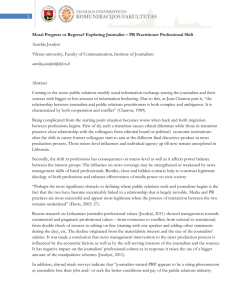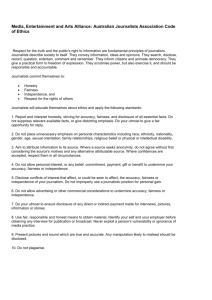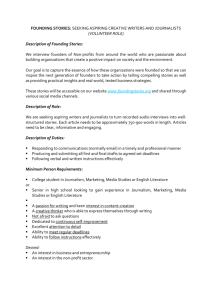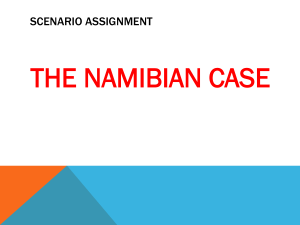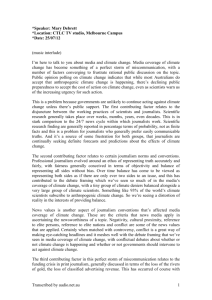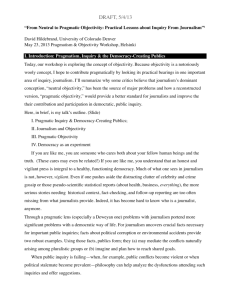Stuart Allan: News Culture
advertisement
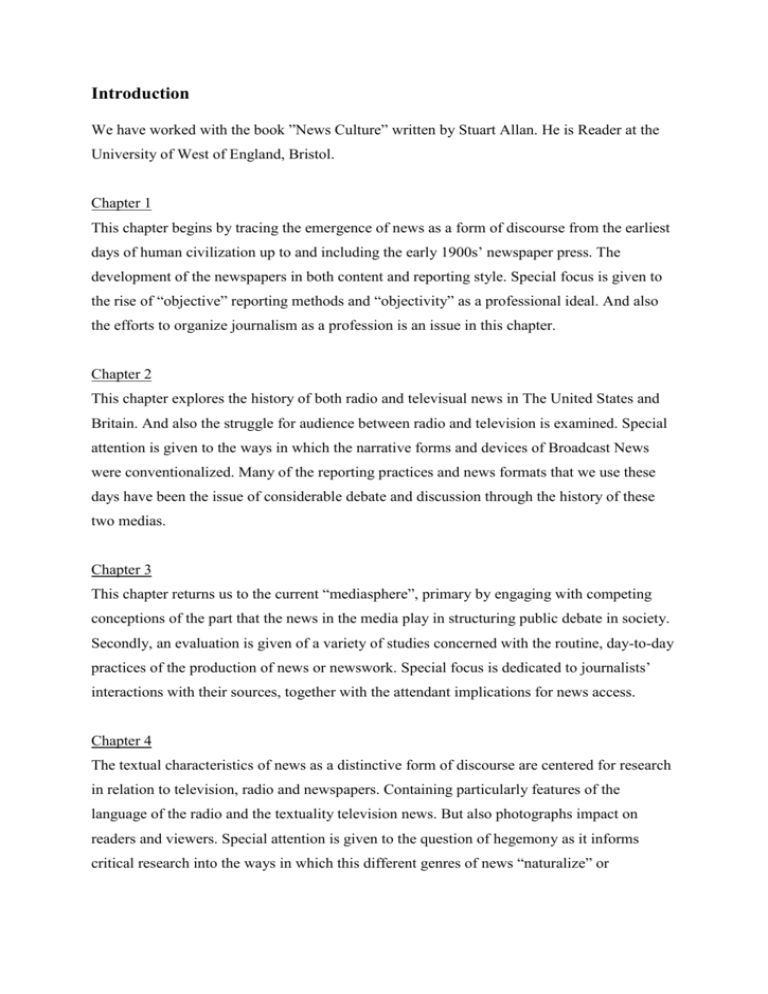
Introduction We have worked with the book ”News Culture” written by Stuart Allan. He is Reader at the University of West of England, Bristol. Chapter 1 This chapter begins by tracing the emergence of news as a form of discourse from the earliest days of human civilization up to and including the early 1900s’ newspaper press. The development of the newspapers in both content and reporting style. Special focus is given to the rise of “objective” reporting methods and “objectivity” as a professional ideal. And also the efforts to organize journalism as a profession is an issue in this chapter. Chapter 2 This chapter explores the history of both radio and televisual news in The United States and Britain. And also the struggle for audience between radio and television is examined. Special attention is given to the ways in which the narrative forms and devices of Broadcast News were conventionalized. Many of the reporting practices and news formats that we use these days have been the issue of considerable debate and discussion through the history of these two medias. Chapter 3 This chapter returns us to the current “mediasphere”, primary by engaging with competing conceptions of the part that the news in the media play in structuring public debate in society. Secondly, an evaluation is given of a variety of studies concerned with the routine, day-to-day practices of the production of news or newswork. Special focus is dedicated to journalists’ interactions with their sources, together with the attendant implications for news access. Chapter 4 The textual characteristics of news as a distinctive form of discourse are centered for research in relation to television, radio and newspapers. Containing particularly features of the language of the radio and the textuality television news. But also photographs impact on readers and viewers. Special attention is given to the question of hegemony as it informs critical research into the ways in which this different genres of news “naturalize” or “depoliticize” certain definitions of reality as being representative of what everyone knows to be true, also known as common sense. Chapter 5 This chapter regards how news texts are actually read or decoded by viewers, readers and listeners. The great variety of uses of news, especially in the household, will be considered so as to discern the lived materiality of the daily practices, rituals, costumes and techniques shaping the negotiation of its meanings within the context of everyday life. The differences between the tabloids, also called popular news, and the so called official news is explored within this chapter as well. The chapter ends with a look at different “uses” of the televisual news, containing textual uses and informational uses, just to mention a couple. Chapter 6 The basis of this chapter is formed by the insights provided by feminist and gender-sensitive critiques of news. Commencing with an analysis of the gender politics of objective reporting, the discussion proceeds to show how the norms and values of white, middle-class male journalists typically sustain a “macho-culture” in the newsroom. Next, the focus turns to the sexist ways in which the news media represents women, especially when it comes to news coverage of incidents of violence committed by men against women. Chapter 7 This chapter presents a distinction between “overt” and “inferential” racism so as to deconstruct the racialized projection of an “us and them” dichotomy in the news. The way in which this dichotomy is maintained, reinforced and contested is examined in relation to the reporting of “law and order” issues, as well as during times of war. This chapter also discusses how the TV-station Al-Jazeera reported on the causualities of the war in Iraq. Lastly, the chapter ends investigating the pressures routinly placed on ethnic minority journalists to “write white”. To “write white” means to produce news accounts which conform to a predominantly white audience’s preconceptions about the social world. Chapter 8 This chapter examines online journalism. It commences by situating journalism within the new world of the internet. Afterwards it proceeds to discern several key innovations in the development of Web-based reporting. Included in the discussion of the emergent forms, strategies and conventions of online news is a consideration of how the Oklahoma City bombing was reported. Next, we turn to the atrocities of September 11, 2001, focusing especially on citizen-produced reporting on the web. Lastly, the challenges posed in covering the war in Iraq are examined by paying special attention at “warblogs” as an alternative type of reporting. Chapter 9 The book draws to a close in this last chapter of this book. In the first instance, it pays particular attention to various critiques of the news media, not least those which contend that real journalism is at risk dissapearing into an “infotainment culture”. In this context, the chapter proceeds to explore television news, before engaging directly with issues around “tabloidization”. Lastly, for rethinking journalistic practice, a variety of strategies for change are identified and explored. The reader is thus encouraged to continue with the work of calling into question the familiar types of assumptions ordinarily made about news culture by both journalists and their critics alike. “News Culture” Stuart Allan 6. The gendered realities of journalism Today it is still a predominantly male domain of work, the dynamics of which are largely shaped by patriarchal norms, values and traditions. Hard news, serious and important are covered by male journalists and soft news or the society news, trivial and insignificant are reported by female journalists. Positions in objectivity in a gendered journalism: - Neutrality position: good report is gender-neutral reporting. - Balance position: only women are justified in speaking for women; news organizations employing equal number of male and female journalists. - Counter position: facts can not be separrated out from their ideological, and hence gendered conditions of production. Masculine discourses about reality held to be objective, rational, abstract, coherent, unitary and active. Femenine are posited as subjective, irrational, emotional, partial, fragmented and passive. Women reportesrs are often compelled to demonstrate that they can be good journalists while still being real, truly feminine women. In Britain’s tabloid The Sun, the case of the topless female models displayed in page three reflects that still has its target audience compouned of middle class white man. In the case of supermarket tabloids in the USA, a distinctly conservative picture of woman is displayed: marriage and children are of prime importance, villanes are those that disrupt the family ideal. Many newspapers commentators are now pointing to what they claim is a growing feminization of the news. News organizations are becoming more inclined to attract female readers, often due to the influence of advertisers. The growth of sex crime coverage in the USA with the sexist and racist assumptions draw upon two types of narratives for women: - The Vamp version: balmming the victim of the crime. (the woman, by her looks, - behavior or generally loose morality drove the man to such extremes of lust that he was compelled to commit the crime) The Virgin version: women can only be Madonnas. (the man, a depraved and perverted monster, sullied the innocent victim, who is now a martyr to the flaws of society ) More women in the news industry is not enough: there need to be more women with a politicised understanding of the ways in which women’s subordination is currently reproduced, and with the will to change it. SUMMARIES OF CHAPTERS 7-9 Chapter 7: Racism in the news -news profits off prejudices creating an US and THEM -media creates ideas about race -> articulates these ideas, worked on, transforms, elaborates these ideas -> created by social relations not just racist people behind the scenes -2 types of racism: 1) overt “open” racism: when media coverage holds openly explicit racist positions and arguments; common in right-wing newspapers; found in tabloids 2) inferential racism: racist propositions are inscribed in media coverage; found in british media; racist statements formulated without an awareness that there is a racist comment based in statement -white people are the norm, those of colour belong to ‘ethnic groups’ -newspapers reflect white point of view -eg. Blacks are seen as dangerous, thieves etc -eg. War coverage: THEY were described in negative terms, WE described as heroes Chapter 8: Journalism on the Web -newspaper companies started placing news reports online -but never held any reliability in the beginning, seen as untrustworthy, lacking objectivity and professionalism -role of internet played a more important role after catastrophic events eg. Earthquakes in California, Oklahoma city bombing, 9/11, iraq war -people started posting their personal online reports -news online had more ‘up-to-date’ coverage than print -reporting 9/11 -eyewitness accounts on the web within 10 mins of crash -rapid, extensive circulation on web -major news sites: cnn.com, msnbc.com, abcnews.com, cbsnews.com, foxnews.com were bombarded with hits -sites almost inaccessible because of demand (millions per hr) -news on internet became source for breaking new stories -creation of ‘personal journalism’/ ‘do-it-yourself reporting: posting eyewitness accounts, personal photos, interpretations and analyses -weblogs circulated, Q&A discussions on major news sites, online chat rooms -more people viewing online news from other countries’ websites -speed and coverage of 9/11 created concerns -‘responsible journalism’ seeked, limitations on coverage -internet was high-speed, with a large capacity that offered live video and audio reports, multimedia slideshows, animated graphics, interactive maps etc. Chapter 9: Journalism is Popular Culture -a rise in ‘info-tainment’, and ‘trash journalism’ with shows like 60 minutes, or nightline -fear that journalists contributing to ‘idiot culture’ -US turning into a ‘talk-show’ nation, with ranting, raving and posturing -news moving away from foreign affairs towards domestic concerns; away from politics towards human-interest stories; away from issues to people – tabloid journalism -industry now aimed towards ratings, and profits -seeking entertainment, target younger viewers for product marketing -to maintain ratings: need to be first, fastest, stories revolving around crime, celebrity and ‘lifestyle issues’ -‘dumbing down’ effect: lack of substance, convergence occurring -‘celebrity news’: 1) not spontaneous; has been planned, planted and incited; not a trainwreck or earthquake, but an interview 2) planted primarily to be reported or reproduced; success is how widely reported on 3) ambiguity in relation to underlying reality 4) intended to be a self-fulfilling prophecy; eg. A hotel’s 30th anniversary -journalism in a state of crisis? -journalistic standards vary within a single news organization -problem may not be technological but economic -convergence between news and entertainment narrowing Newsworthiness “News is a social resource which through its very construction implies a series of particular constraints or limit on the form of knowledge which can be generated and called reality” The role of the journalist nowadays is keeping the connection between the economical and political power and the audience. A newsworker is said to be shaping the public opinion, and the public opinion itself can be considered capable of orienting the governamental choices. Newsmaking is a market-oriented process. What makes news worthy? Generally speaking, the main purposes that news making has to fulfil are three: 1. Economical: that means that news have to be made appealing to the audience so that to increase the number of copies sold; 2. Poitical: to find a general consensus in public opinion in order to support a political party 3. Social and cultural: to carry given values and rules, as well as hierarchies, that can be of help to audience to have a clear idea of society itself and its processes (often giving the idea of society as a given and monolithic ensemble of rule and settings that can’t be changed). “World has to be made reportable”, in order to reflex a selected image of the world itself. Journalists and objectivity: newsworkers pretend to be objective, but as soon as they start selecting stories and turning them into news, they naturally use frames (that are principle of organization that work to impose order on the multiple happenings of the social world so as to render them in a series of meaningful events), and how a journalist frame in order to be as much objective as possible, that makes an ideological significance. Framing takes into account also a principle of inclusion and exclusion. Moreover, objectivity of the news is connected also with the objectivity of the sources. There are several features that make certain events favoured to be turned into news: Conflict: dramatization and conflict Relevance: the event should be seen to impinge, both directly and indirectly, audiences lives and experiences. Proximity to the audiences. Timeliness: recent events are favoured, especially those whose developments can constantly be monitored by the media. Simplification: the significance must be kept unambiguous, and the potential differences in interpretations to the minimum Personalization: stress on human actors rather than on abstract concepts of institutions and companies Unexpectedness: “out of the ordinary” events are favoured. Composition: a mixture of events must be processed on any given day so that to fill in the news hole. References to elite nations: most important nations of the first world seem to be preferred in news selecting, as third world countries are not really considered. Also because certain countries can directly affect audience’s well-being. Reference to elite persons: ordinary people are not so relevant, celebrities are. Cultural specificity: stress on “people like us” rather that on events that so not share the same map of meaning Negativity: bad news are favoured on good news. McLuhan stated that the only good news in newspapers are advertisements. Media and hegemony Journalists are seen as story tellers whose choice of the news indirectly shape the audience’s perception of the world, as it mainly derive its sense and convictions about society from public events; the audience trust news, it relies on it in order to outline a representation of the world. Moreover, journalists are believed to be objective, as news reporting can help naturalizing a politics of legitimacy that can lend justifications to society’s distribution of power and influence. Hegemony: “a relation of spontaneous consent given by the great masses of population to the general direction imposed o social life by the dominant fundamental group; this consent is “historically” caused by the prestige (and consequent confidence) which the dominant group enjoys because of its position and function in the world of production.”(A. Gramsci) In order to be hegemonic, the dominant group needs to have a political and ideological leadership that can shape what can be called the dominant “common sense”, an ensemble of norms and beliefs-to which the subordinate groups have to adapt- deeply rooted in everyday life; hegemony implies an ideological struggle over this imposed common sense. Three main characteristic of hegemony can be remarked: 1. Hegemony is a living process, as it is rooted-as shared common sense- into everyday life’s practices of the individuals. “Hegemony is embodied in a lived system of meaning and values “ (Williams). 2. So, hegemony is a matter of common sense, which is always changing. It can be described as a sedimentary ensemble of beliefs that are assumed and rejected in a daily and always-changing routine. 3. Hegemony is always being negotiated, and it can never be taken for granted by the ruling group. These assumptions reflects onto the media system and onto the daily struggle to maintain a shared common sense also useful to select worthy news.
